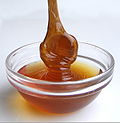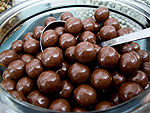Maltose
| Maltose | |
|---|---|

| |
| General | |
| Systematic name | α-D-glucopyranosyl- (1→4)-β-D-glucopyranose |
| Other names | malt sugar |
| Molecular formula | C12H22O11 |
| SMILES | C(C1C(C(C(C(O1)OC2C(OC (C(C2O)O)O)CO)O)O)O)O |
| Molar mass | Molar mass::342.296 g/mol |
| Appearance | powder of white crystals |
| CAS number | CAS number:: 69-79-4 |
| Properties | |
| Density and phase | [[Density::1.54 g/cm3]], liquid/carmel like |
| Solubility in water | 58.3 g/100 ml (49.4°C) |
| Melting point | Melting point::103°C |
| Boiling point | Boiling point::667.9°C |
| Hazards | |
| MSDS | Material safety data sheet of maltose |
| Main hazards | Keep away from eyes and skin may cause irritation |
| NFPA 704 | |
| R/S statement | R: R36, R37, R38 S: S2, S20, S22, S24,S25, S26, S46, S62 |
| RTECS number | OO5250000 |
| Related compounds | |
| Related | Sucrose,Lactose,Trehalose,Cellobiose |
| Except where noted otherwise, data are given for materials in their standard state (at 25 °C, 100 kPa) Disclaimer and references | |
Maltose is an organic compound - is a disaccharide formed from glucose molecules. Although many people do not know what maltose is, it is a fundamental part in many foods. Maltose is key in the process of life in the natural world in plants, animals and as well in humans. As maltose is a fundamental part in our lives, and is seen in almost everything it's quite amazing that hardly anyone knows what maltose really is. Maltose is a very malleable and functional compound that is one of the best for adding flavor.
Properties
Maltose is made up of two units of glucose that make up maltose and form its special bond. This bond between the two glucoses is made when you break down amylase with starch and then as a disaccharide maltose is formed. Maltose appears as a white powder or as crystals and is soluble in water at 1,080 g/mL[1]. Although maltose is seen as a food ingredient, it is also used to make or form foods, as to brew beer like malt-liquor. When you add a third unit of glucose you can make maltotriose and if you add more you can create maltodextrins [2]. Maltose can be developed under natural conditions through microorganisms that degrade the starch with enzymes found in the plants. This process is also seen by the enzymatic break down of plant starch[3].
Occurrences
Maltose is a disaccharide that is formed by the enzymic hydrolysis of starch. These processes can be formed by man and can be formed from natural occurrences such as in most plants. This compound maltose can be seen in most foods such as baking foods, beverages, confectionary, liquors, and infant food[4]. Maltose is as well created by digestive juices for animals and humans, germinated grains, saprophytic fungi, and yeast. Maltose is very important in the life process of organisms.[5].
Uses
Maltose is a carbohydrate that is used as an energy source for muscles and other cellular processes. Maltose is also used in making many foods and beverages. In the syrup form of maltose, there are some in particular of maltose seen in cakes, candy , beer, chemicals, bakery products, and as food additives [6]. Beyond the uses in foods and the production of energy in the body maltose also helps humans for their hair and also for the heart health. Without maltose the heart becomes weak. [7]. There is a multitude of foods that have a high amount of maltose in it such as McDonald’s Triple thick shake, baby food, McDonald’s honey,fat free Thousand Island dressing, Pizza Hut pepperoni Thick crust, and ect. To see more foods high in maltose visit this link-->[8].
How To Reduce a Maltose intake in dieting
The first step in reducing maltose in a diet, is to consult your doctor and ask them for helpful hints in reducing a maltose in a diet. Second step is to purchase a nutritional guide that breaks down food by ingredients minerals sugars and types of components such as proteins, carbohydrates and fats. Make a list of things that are high in maltose by following the link toward high maltose products above^. Another way to keep a good track of what you eat is to make a journal and to know what you are actually eating through out the day and if you have issues toward maltose or have Disaccharide intolerances, this site should be recommended--->[9].
References
- ↑ Chelsey from Cornell. Maltose Cornell.”Cornell Bio Chem”. Web. January 30 2012.
- ↑ [1]. “Wise Geek”. Web. January 30, 2012.Unknown Author
- ↑ [2]. GMO Database. Web. December 10,2008. Unknown Author
- ↑ [3]. GMO Database. Web. December 10,2008. Unknown Author
- ↑ N. D. GABRIELIAN [4]. The Free Dictionary. Web. January 30, 2012
- ↑ Maltose syrup products. DHgate factory. Web. January 30, 2012. Author Unknown
- ↑ Chelsey from Cornell. Maltose Cornell.”Cornell Bio Chem”. Web. January 30 2012.
- ↑ Foods with High Maltose. Self Nutrition Data. Web. January 30, 2012. Unknown Author
- ↑ Merle Huerta [5]. How to Reduce Maltose Sugars. Web. January 30, 2012
| ||||||||||||||



